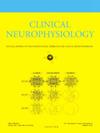儿童癫痫与丘脑睡眠纺锤波相关的快速纹波带高频活动。
IF 3.7
3区 医学
Q1 CLINICAL NEUROLOGY
引用次数: 0
摘要
目的:探讨与丘脑睡眠纺锤波相关的高频活动。方法:我们研究了一组10例儿童顽固性癫痫患者,他们被确定为丘脑神经调节的潜在候选者。使用取样频率为2000赫兹的立体定向脑电图(SEEG)对这些患者进行丘脑取样以及假定的癫痫区。我们利用非快速眼动睡眠期间20分钟的头皮EEG和SEEG记录,量化与睡眠纺锤波相关的快速纹波带的高频活动(HFA),并分析其与纺锤波特征的相关性。结果:HFA在丘脑中被显著观察到,峰值中位数频率为330 Hz,且与丘脑睡眠纺锤波具有时间相关性。这种HFA与11-16 Hz的睡眠纺锤波范围具有显著的耦合性。HFA持续时间与伴随丘脑纺锤体密度高、持续时间长呈正相关。丘脑HFA持续时间与皮层间期癫痫样放电呈负相关。在HFA通道中产生的丘脑纺锤波通常与大脑不同区域的睡眠纺锤波一致。结论:快速纹波带HFA与睡眠纺锤波的关系仅在丘脑中观察到。意义:丘脑HFA与丘脑纺锤体相关可能代表了一种丘脑特异性生理现象。本文章由计算机程序翻译,如有差异,请以英文原文为准。
Fast ripple band high-frequency activity associated with thalamic sleep spindles in pediatric epilepsy
Objective
To investigate high-frequency activities (HFA) associated with thalamic sleep spindles.
Methods
We studied a cohort of ten pediatric patients with medication resistant epilepsy who were identified as potential candidates for thalamic neuromodulation. These patients had thalamic sampling as well as presumed epileptogenic zones, using stereotactic EEG (SEEG) with a sampling frequency of 2,000 Hz. We quantified the summated high-frequency activity (HFA) in the fast ripple band associated with sleep spindles using 20-minute scalp EEG and SEEG recordings during non-REM sleep and analyzed its correlation with spindle characteristics.
Results
HFA, with a median peak frequency of 330 Hz, was distinctively observed in the thalamus and temporally correlated with thalamic sleep spindles. Such HFA demonstrated significant coupling with the sleep spindle range of 11–16 Hz. The duration of HFA positively correlated with higher density and longer duration of accompanying thalamic spindles. Thalamic HFA’s duration negatively correlated with the presence of cortical interictal epileptiform discharges. Thalamic spindles generated in channels with HFA often coincided with sleep spindles in various brain regions.
Conclusion
Fast ripple band HFA associated with sleep spindles was observed exclusively in the thalamus.
Significance
Thalamic HFA associated with thalamic spindles may represent a thalamus-specific physiological phenomenon.
求助全文
通过发布文献求助,成功后即可免费获取论文全文。
去求助
来源期刊

Clinical Neurophysiology
医学-临床神经学
CiteScore
8.70
自引率
6.40%
发文量
932
审稿时长
59 days
期刊介绍:
As of January 1999, The journal Electroencephalography and Clinical Neurophysiology, and its two sections Electromyography and Motor Control and Evoked Potentials have amalgamated to become this journal - Clinical Neurophysiology.
Clinical Neurophysiology is the official journal of the International Federation of Clinical Neurophysiology, the Brazilian Society of Clinical Neurophysiology, the Czech Society of Clinical Neurophysiology, the Italian Clinical Neurophysiology Society and the International Society of Intraoperative Neurophysiology.The journal is dedicated to fostering research and disseminating information on all aspects of both normal and abnormal functioning of the nervous system. The key aim of the publication is to disseminate scholarly reports on the pathophysiology underlying diseases of the central and peripheral nervous system of human patients. Clinical trials that use neurophysiological measures to document change are encouraged, as are manuscripts reporting data on integrated neuroimaging of central nervous function including, but not limited to, functional MRI, MEG, EEG, PET and other neuroimaging modalities.
 求助内容:
求助内容: 应助结果提醒方式:
应助结果提醒方式:


